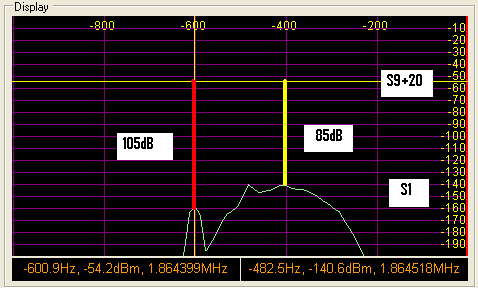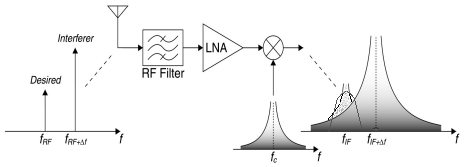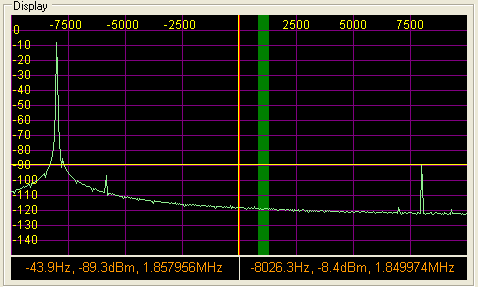
Adjacent Channel Tests:

MDS is a useful figure of merit to understand the single signal sensitivity
of the input stage of a well designed receiver. But, in use our receivers
are subject to a plethora of signals at its input. These signals combine
with each other and with the local oscillator and its associated phase
noise. For example, lets say you are receiving a distant station just
above the noise floor and a second station transmits a CW carrier
just 200 Hz lower in frequency at a signal level of S9 +20 dB. What
happens to the weak signal? In the case of the SDR1000, the S9 +20
signal has no effect on the weak signal. There are three receiver
attributes that determine performance in this case, selectivity,
overload, and LO phase noise.
The SDR1000 utilizes near brick wall, no ring DSP filtering. The figure
above shows the results of this example. The marker cross hairs are
placed at the input signal, the frequency and level are annotated in
the lower left pane. You can see that the S9+ signal is attenuated
105dB (-55dBm - (-160dBm))! Selectivity is not an issue here. Back
in figure 3 we see the noise floor is -143dBm/10Hz, notice above that
it is now -140.6dBm/10Hz. This reduction in sensitivity is due to LO
phase noise. It is a combination of the phase noise at 200 Hz and at
11 KHz.
In the first case the (LO + 200Hz) phase noise
mixes with the S9 +20
dB signal and falls onto the weak signal IF frequency. This is referred
to as reciprocal mixing. Also the 11KHz phase noise mixes with the
VFO center frequency and falls into the 11 KHz IF. Think about it,
you can copy an S1 CW signal 200Hz away from an S9 +20dB
carrier. That's 85 dB .
Blocking Dynamic Range is a measure of how large the interferer can be
before it effects the weak signal. As you would expect most receivers
have more difficulty the closer the two signals. The
League commonly
makes this measurement with signals separated by 20 KHz with most
radios performing in the 80-100dB range in a 500 Hz bandwidth.

Here's a nice diagram of what's going on in the
last example. Only here
the wanted signal is lower in frequency than the interferer.
To quote a former president "It's the Phase
Noise Stupid". Remember,
no amount of filtering will undo the ill effects of a poor performing
local oscillator. It is phase noise that separates a good radio from a
real performer.

Here are two signals separated by 16 KHz and
85dB. It's clear from the
graph that the SDR can discern a weak signal down another 30dB or
113dB/10Hz. The interfering signal level is S9 +65dB! Notice that the
noise floor has increased about 20dB. Is this due to the interferers
phase noise, the SDR LO phase noise or both? Stay tuned.
Copyright 2006
John Eckert
k2ox